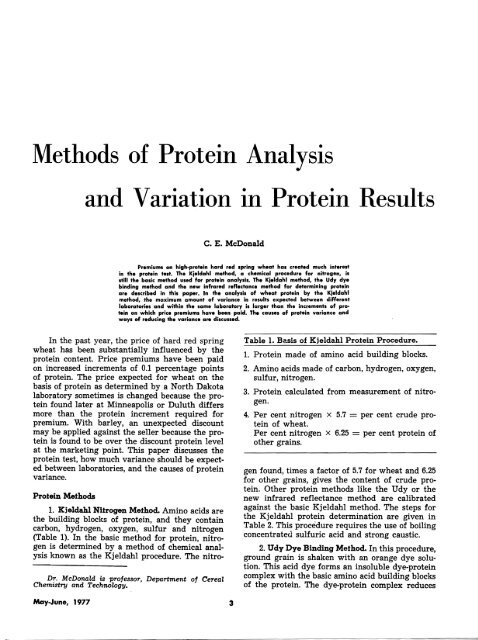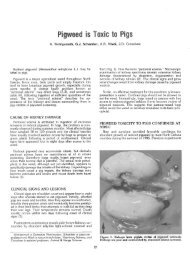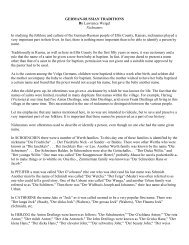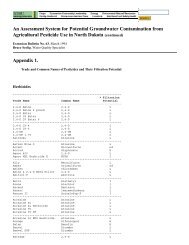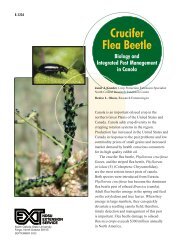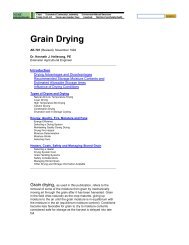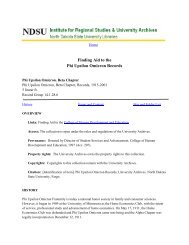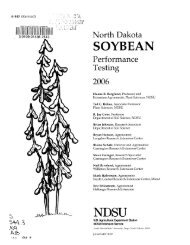Create successful ePaper yourself
Turn your PDF publications into a flip-book with our unique Google optimized e-Paper software.
Table 4. Expected Variance in a. 14 Per Cent <strong>Protein</strong>Wheat Having a 0.16 StandardDeviation.ProbabilityExpected protein range% %67 13.84-14.16 (± 0.16)95 13.68-14.32 (± 0.32)99.74 13.52-14.48 (± 0.48)cent protein, the value could be between 13.84 and14.16 per cent protein (14.0 ± 0.16) 67 per cent <strong>of</strong>the time. There would also be, for a single analysis,a 95 per cent probability that the value wouldbe within ± 2 S.D.; wheat <strong>of</strong> 14.0 per cent proteincould show a range from 13.68 to 14.32 per centprotein (14.0 ± 0.32). What about the 5 per cent <strong>of</strong>the time when the variation is greater than ± 2S.D.? There is a 0.26 per cent probability that thevariation would be greater than ± 3 S.D. or forwheat, a variation greater than 0.48 percentageprotein from the actual value. This wide variationcan be expected in about one out <strong>of</strong> every 400analyses. These variances in protein between proteinlaboratories is the reason why there can bedifferences in the total wheat price when premiumsare paid on 0.1 per cent increments <strong>of</strong> protein.The protein variance that can be expected inthe same laboratory is indicated by the data presentedin Table 5. The variance is lower than betweendifferent laboratories (Table 3), but it wouldbe enough to cause some problems in price whenpremiums are paid on increments <strong>of</strong> 0.1 percentageprotein.Table 5. Variance in <strong>Protein</strong> Results in a <strong>Protein</strong>Laboratory at North Dakota State University.SampleWheat grain 2Wheat flourNumberanalysis'1515<strong>Protein</strong> contentlow high Avg.% % %14.114.114.514.314.414.2Standarddeviation%0.110.06'A single analysis ran for 15 different days.2A new lot <strong>of</strong> the grain sample was ground each day forthe analysis.The standard deviations on wheat grain bythree methods <strong>of</strong> protein analysis as reported byWilliams (1,2) are 0.15, 0.30 and 0.17 percentageprotein by the Kjeldahl, Udy, and infrared reflectancemethods, respectively. These data were obtainedbetween different Canadian laboratories orbetween different infrared instruments. As shownby Williams (1,2) the new infrared reflectancemethod appears to be almost as good as the Kjeldahlprocedure. <strong>Protein</strong> variance and suitabilityfor protein analysis by an infrared instrument isnow being studied at North Dakota State University.Causes <strong>of</strong> <strong>Protein</strong> Variance1. Sampling. A number <strong>of</strong> factors that cancause protein variance are listed in Table 6. Undersampling there are several areas where errors canoccur. For example, the 4-5 lb. grading sampleobtained by probe from a box car by a samplermay not be <strong>of</strong> the same protein content as thewhole large bulk <strong>of</strong> wheat. Uneven areas <strong>of</strong> highand low protein make it difficult to obtain a trulyrepresentative protein sample.Table 6. Factors That Can Affect <strong>Protein</strong> Results.1. Sampling.a. Of original grain (4-5 Ib).b. Subdividing grain sample (2 Ib).c. Sampling grading or submitted sample forgrinding (1 oz).d. Sampling ground sample for protein test (1gram or A..l 1/28 oz).2. Cleanliness <strong>of</strong> grain.3. Moisture content <strong>of</strong> grain.a. Original moisture.b. Moisture loss on grinding.4. <strong>Protein</strong> differences in particles <strong>of</strong> ground grain.5. Laboratory techniques.Bin samples brought into the protein laboratoryby individuals should also be obtained byproper sampling procedures to get a truly representativesample. The assumption that the proteinis exactly the same throughout the bin would beexpected to be true only if there is a single varietyinvolved, and the soil, fertilizer availability andmoisture availability to the wheat plant were uniformduring growth throughout the field or fieldsin which the wheat was grown. This assumption <strong>of</strong>even protein throughout the bin may be a majorcause <strong>of</strong> error in submitted samples.The 4-5 lb. sample obtained by a sampler isdivided into two parts on a Boerner divider. Onepart <strong>of</strong> the sample is sent to the grading and proteinlaboratory in North Dakota and the other tothe place <strong>of</strong> marketing. Improper dividing cancause differences in protein. After removing dockage,about a 1 oz. sample is obtained for grindingin the protein laboratory, and 1 gram (1/28 oz.) <strong>of</strong>the ground material is weighed for the proteintest. Sampling errors can occur on the 1 oz. sampleused for grinding or on the 1 gram sample for thetest if there is uneven protein in the larger bulk<strong>of</strong> wheat from which the sample was taken.May-June, 1977 5
2. Cleanliness <strong>of</strong> Grain. The second factorthat might cause protein variance is the cleanliness<strong>of</strong> the grain (Table 6). The protein content <strong>of</strong>some dockage material is given in Table 7. Smallamounts <strong>of</strong> high-protein soybeans and wild oatsin wheat or barley samples could increase proteinresults, while low-protein straw and chaff couldTable 7. <strong>Protein</strong> Content <strong>of</strong> Dockage and ExtraneousMaterial Found in Grain.Material<strong>Protein</strong> content%Buckwheat 13Pigeon grass 14Soybeans 40Straw and chaff 3Wild oats 19decrease them. The protein <strong>of</strong> buckwheat andpigeon grass is near that <strong>of</strong> wheat, so smallamounts probably would not have a significanteffect on protein. Routinely, grain is cleaned beforea sample is taken for grading or a proteinanalysis.3. Moisture Content <strong>of</strong> Grain. The third factorthat can affect protein results is the moisture content<strong>of</strong> the grain. The extent <strong>of</strong> protein change ingrain due to differences in moisture is illustratedin Table 8. First, a dry sample <strong>of</strong> 14.0 per cent proteincontains 86 per cent nonprotein dry matter.This same sample with 10.0 per cent moisture nowcontains only 12.6 per cent protein because thesample has been diluted with water, and for thesame reason the sample <strong>of</strong> 14.0 per cent moisturewill contain only 12.1 per cent protein. Whenlarge enough moisture changes occur in grainthere is also a change in the protein content. Forthis reason, grain samples to be tested should alwaysbe stored in air-tight containers.Table 8. <strong>Protein</strong> Content at Different MoistureLevels.Moisture Per cent <strong>of</strong> dry sample <strong>Protein</strong>content water protein nonprotein total wt. content'% % % % % %0 0 14.0 86.0 100 14.010 11 14.0 86.0 111 12.614 16 14.0 86.0 116 12.1'<strong>Protein</strong> content = <strong>Protein</strong> as % <strong>of</strong> dry samEZe X 100Total wt. as % <strong>of</strong> dry sampleMoisture can also be lost during the grinding<strong>of</strong> the wheat with resulting changes in protein.Table 9 illustrates the moisture changes with threemills commonly used for grinding grain for proteinanalysis. The Labconco and Hobart burr millsTable 9. Moisture Loss on Grinding Wheat Grainfor <strong>Protein</strong> <strong>Analysis</strong>.12.2% 16.2%Moisture graini Moisture grainiMoisture Change <strong>of</strong> Moisture Change <strong>of</strong>after protein after proteingrinding' content grinding' contentMill used % % % %Labconco Burr 12.4 0.0 16.1 0.0Hobart Burr 12.3 0.0 16.2 0.0Udy Cyclone 3 10.9 +0.2 13.4 +0.5I Determined with the Matomco moisture meter.'Determined by the 130 0 C. air-oven method.3 A 0.5 mm. sieve was used in the mill.are used in most protein laboratories and the Udycyclone mill for grinding samples for analysis bythe Udy method. The two burr mills caused verylittle moisture loss on grinding wheat, even whenthe moisture content <strong>of</strong> the wheat was 16.2 percent. The Udy cyclone mill caused considerablemoisture loss and a change in protein. For example,a sample having an initial 12.2 per centmoisture in the wheat showed a 0.2 percentageincrease in the protein content. With the 16.2 percent moisture wheat, an increase <strong>of</strong> 0.5 percentage<strong>of</strong> protein occurred due to moisture loss. <strong>Protein</strong>changes due to moisture loss should be consideredwhen using the Udy mill or similar type mill.In the grain market, wheat protein content isexpressed on an "as is" moisture basis. As alreadyshown, the protein content on this basis changeswith moisture content. The protein can also beexpressed on a specific moisture basis so that thereis no protein variance with moisture. Barley proteinin the grain market is expressed on a dryweight basis (0 per cent moisture in sample).Wheat and flour moisture is expressed in scientificlaboratories in the United States on a 14 per centmoisture basis.4. <strong>Protein</strong> Differences in Particles <strong>of</strong> GroundGrain. The fourth factor that can affect proteinresults is protein differences in particles <strong>of</strong> groundgrain (Table 6). The endosperm <strong>of</strong> grain is notuniform in protein. In hard wheat, Kent (3) hasreported a protein content <strong>of</strong> 8 per cent in thecenter portion <strong>of</strong> the endosperm to 43 per centnear the bran layers. He also found that the flourcontained material <strong>of</strong> high and low protein content.One would also expect ground grain to havea mixture <strong>of</strong> particles that would differ in proteincontent.The data <strong>of</strong> Table 10 shows 3 to 4 percentagepoints difference in protein content between particles<strong>of</strong> hard red spring wheat when the Labconcoand Hobart burr mills are used. The Udy cyclonemill produced particles that were found to differonly 1 percentage point in protein content. Thus6 Farm Research
Table 10. <strong>Protein</strong> Content <strong>of</strong> Particles in GroundHard Red Spring Wheat (Waldron variety).Particle size, micrometers 1Mill Used >1 ,000 920 670 398 358 223


